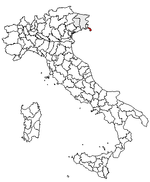
Villa Opicina
Encyclopedia


Italy
Italy , officially the Italian Republic languages]] under the European Charter for Regional or Minority Languages. In each of these, Italy's official name is as follows:;;;;;;;;), is a unitary parliamentary republic in South-Central Europe. To the north it borders France, Switzerland, Austria and...
, close to the Slovenia
Slovenia
Slovenia , officially the Republic of Slovenia , is a country in Central and Southeastern Europe touching the Alps and bordering the Mediterranean. Slovenia borders Italy to the west, Croatia to the south and east, Hungary to the northeast, and Austria to the north, and also has a small portion of...
n border at Fernetti (Slovene: ). The first town in Slovenia after the border is Sežana
Sežana
Sežana is a town and a municipality in the Slovenian Littoral region of Slovenia, near the border with Italy. According to the census of 2008, it has a population of 12,470, of which around 5,332 live in the town of Sežana and the rest in the neighbouring rural areas.Sežana is located about on the...
, which is also where the first railway station in Slovenia is located after Villa Opicina.
Villa Opicina is a frazione
Frazione
A frazione , in Italy, is the name given in administrative law to a type of territorial subdivision of a comune; for other administrative divisions, see municipio, circoscrizione, quartiere...
of the comune
Comune
In Italy, the comune is the basic administrative division, and may be properly approximated in casual speech by the English word township or municipality.-Importance and function:...
of Trieste
Trieste
Trieste is a city and seaport in northeastern Italy. It is situated towards the end of a narrow strip of land lying between the Adriatic Sea and Italy's border with Slovenia, which lies almost immediately south and east of the city...
, the provincial and regional capital.
It is inhabited by a Slovene minority. According to the last Austrian census of 1911, over 89% of the population was of Slovene ethnicity. In the following decades, this number fell significantly: according to the census of 1971, just above half of the population of the settlement belonged to the Slovene speaking community, while the rest were mostly Italian speakers. In the last three decades, immigration from the city of Trieste and other predominantly Italian-speaking areas have most probably reduced the Slovene speakers to a minority. However, Slovene language is still widely used in the settlement, both in private and public life. Most of the official signs are in both languages, Italian and Slovene.
Geography
It is located on the Carso PlateauKras
Karst ; also known as the Karst Plateau, is a limestone borderline plateau region extending in southwestern Slovenia and northeastern Italy. It lies between the Vipava Valley, the low hills surrounding the valley, the westernmost part of the Brkini Hills, northern Istria, and the Gulf of Trieste...
3 miles north of Trieste
Trieste
Trieste is a city and seaport in northeastern Italy. It is situated towards the end of a narrow strip of land lying between the Adriatic Sea and Italy's border with Slovenia, which lies almost immediately south and east of the city...
, a seaport on the Adriatic Sea
Adriatic Sea
The Adriatic Sea is a body of water separating the Italian Peninsula from the Balkan peninsula, and the system of the Apennine Mountains from that of the Dinaric Alps and adjacent ranges...
.
The railway station serves trains entering Italy from Slovenia, but does not provide a direct service to Trieste. The Opicina Tramway
Opicina Tramway
The Opicina Tramway is an unusual hybrid tramway and funicular railway in the city of Trieste, Italy. It links Piazza Oberdan, on the northern edge of the city centre, with the village of Villa Opicina in the hills above....
, a unique hybrid tramway and funicular railway
Funicular
A funicular, also known as an inclined plane or cliff railway, is a cable railway in which a cable attached to a pair of tram-like vehicles on rails moves them up and down a steep slope; the ascending and descending vehicles counterbalance each other.-Operation:The basic principle of funicular...
links Villa Opicina village with Piazza Oberdan in Trieste city centre. There are also buses which link Villa Opicina rail station, the village center and Trieste.
Name
The name Opicina is of Slovene origin (meaning 'community'), thus being one of the many Italian towns and villages in Friuli-Venezia GiuliaFriuli-Venezia Giulia
Friuli–Venezia Giulia is one of the twenty regions of Italy, and one of five autonomous regions with special statute. The capital is Trieste. It has an area of 7,858 km² and about 1.2 million inhabitants. A natural opening to the sea for many Central European countries, the region is...
with a name of Slavic
Slavic languages
The Slavic languages , a group of closely related languages of the Slavic peoples and a subgroup of Indo-European languages, have speakers in most of Eastern Europe, in much of the Balkans, in parts of Central Europe, and in the northern part of Asia.-Branches:Scholars traditionally divide Slavic...
origin. Before World War I
World War I
World War I , which was predominantly called the World War or the Great War from its occurrence until 1939, and the First World War or World War I thereafter, was a major war centred in Europe that began on 28 July 1914 and lasted until 11 November 1918...
, it used to be known in Italian as Opcina, a name still used in the local Triestine dialect. During the Fascist regime, the name was first Italianized
Italianization
Italianization or Italianisation is a term used to describe a process of cultural assimilation in which ethnically non or partially Italian people or territory become Italian. The process can be voluntary or forced...
into Villa Opicina, and subsequently renamed to Poggioreale del Carso. In 1966 it was renamed again into Villa Opicina. However, it has been frequently referred simply as Opicina, including in the road signs.

